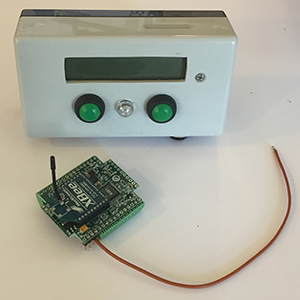Wireless SUMS
(wSUMS)

Whereas the iButton SUMS is a logger that connects directly to a hot part of the stove and requires that someone enter a residence periodically to retrieve, download, and replace it, wSUMS is an effort to eliminate the repeated intrusion. The underlying idea was again to verify that an "improved" stove was actually being used in lieu of an open fire or primitive stove that burned less efficiently and emitted higher levels of carbon dioxide, toxics and particulates. Verification that improved stoves were actually being used was a big motivation for the project as a business proposition in relation to putative carbon credits, but it was also important to verify that the alternative stoves were really and effectively being used for the benefit of the intended recipients and the agencies that purportedly subsidized the efforts. There have been many "improved" stoves that are impractical and sit idle for reasons ranging from cooking and cultural imperatives to mechanical failures and lack of spare parts.
On the technical side, wSUMS uses thermocouples to measure stove temperatures and a data logger to accumulate patterns of stove usage based on temperature and time thresholds. When a researcher passes by, data is transfered through a wireless link (ieee 802.15.4 1mW radio) which has an open field range of approximately 100m, although with walls and clutter that is significantly reduced. Reception is bad next to a floor or behind a chicken coop. With thoughtful placement, reception was good enough to work when the receiver paused on the road outside the instrumented village household. Initially we envisioned running the loggers from thermoelectric generator attached to stove chimneys. However, between insufficient temperature gradients, relatively low percentage of cooking time, and the requirement to keep the radio alive, that plan did not work out. The unit as realized was powered by AA batteries. We decided early on to limit the radio packets to 100 bytes, both to extend the battery life, and also to enforce discipline on the amount of data, to limit it to the most essential. To this end there were many discussions of how best to summarize the minute to minute temperature and time data into daily statistics, to fit into the 100 byte packet that could then be retrieved at roughly 2 week intervals. These are factors of total usage in time and degree-days, and also a count of "meals", which was the most difficult abstraction. Those discussions continued in earnest at the field sites as researchers there contributed their ideas and priorities. These ideas have gone on to inform subsequent work.
2229 5th Street, Berkeley, CA 94710 • (510) 848-5725 •

